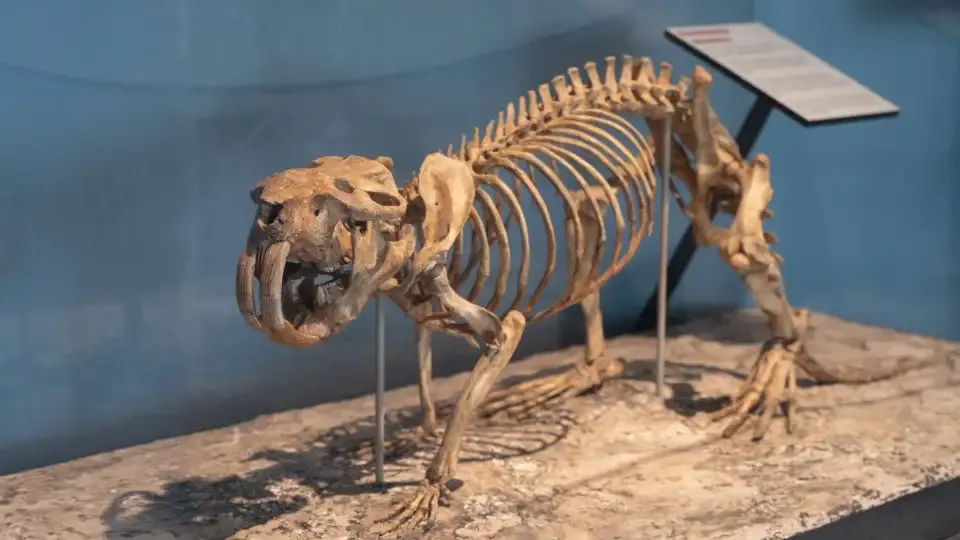Bear-Sized Giant Beavers Once Roamed North America, and They’re Now the Official State Fossil of Minnesota
The large, extinct creatures roamed the Twin Cities area more than 10,000 years ago and could grow to more than 200 pounds

It’s official: Minnesota’s state fossil is the giant beaver, an extinct creature the size of a small bear that roamed around the Twin Cities more than 10,000 years ago.
Lawmakers had approved the new state fossil earlier this year as part of a broader omnibus bill, which Governor Tim Walz signed into law in May. The bill—which included a short provision about the gargantuan Ice Age rodent—officially took effect July 1, report Dana Ferguson, Peter Cox and Clay Masters for MPR News. (Minnesota now has a state constellation, too: Ursa Minor, also known as the Little Dipper.)
“Minnesota has a deep connection to beavers—from our modern ecosystems to our prehistoric past,” Alex Hastings, a paleontologist at the Science Museum of Minnesota, said in a May statement. “The giant beaver fossil specimens in our collection have long captivated visitors of all ages, making this massive Ice Age mammal the perfect symbol of our state’s ancient natural history.”
The giant beaver’s journey to becoming Minnesota’s state fossil has been a long and winding one. The saga dates back to at least 1988, when a group of third graders first proposed making the massive mammal the official state fossil, according to Minnesota Star Tribune columnist Jennifer Brooks. Since then, the proposal has come up again and again. Each time, lawmakers have said no—but that changed this year.
Fun facts: Official state fossils
- Montana’s state fossil, the duck-billed dinosaur Maiasaura peeblesorum, has had its remains sent to space.
- Washington, D.C., selected “Capitalsaurus,” an unofficial name given to a vertebra from a large theropod dinosaur found in the city during sewer work in 1898, as its dinosaur fossil.
Giant beavers (Castoroides ohioensis) were aquatic mammals that lived during the Pleistocene. They probably looked and acted a lot like today’s beavers, but they grew to much larger proportions. The prehistoric “rodent of unusual size” could reach seven feet long and weigh more than 200 pounds.
Fossil hunters have discovered nearly complete remains of the species in Minneapolis and Saint Paul and uncovered fossils in Freeborn County, which is located in the southern part of the state near the border with Iowa. The creature is known as “Ċapa” in Dakota and “Amik” in Ojibwe, the languages of two Indigenous tribes that have long lived in what is now Minnesota.
“What’s really fun about the giant beaver is that it would have actually been around when the first people were settling into Minnesota,” Hastings told MPR News’ Dana Ferguson in February. “So, the first inhabitants in this land would have been encountering the giant beaver.”
In 2021, the Science Museum of Minnesota made another push for the designation of an official state fossil when it asked residents to vote for their favorite contender. Other options included the scimitar-toothed cat, an extinct species of bison and a large, squid-like creature called Endoceras. But in the end, it was the giant beaver that won over the hearts and minds of Minnesotans.
This spring, lawmakers once again took up the issue, hearing testimony from experts with the Science Museum of Minnesota and the Bell Museum on the University of Minnesota Twin Cities campus in Saint Paul. Both institutions have giant beaver fossils in their collections.
“The one animal that gets the biggest ‘wow’ from our Bell Museum visitors is not the life-sized woolly mammoth, but the giant beaver (Castoroides ohioensis)—presented as a life-size model on a glacier, alongside a jaw fossil collected from Blaine,” said Holly Menninger, executive director of the Bell Museum, to Eden Prairie Local News’ Stuart Sudak in May.
Lawmakers were finally convinced. While debating other important issues, like the state budget and fraud mitigation, they agreed to make the giant beaver the state fossil.
“It’s still a good time to remember our history and what we think is important to the state,” Jim Abeler, a state senator from Anoka, Minnesota, said at the proceedings, as reported by the Minnesota Star Tribune. “If you were going to have a state fossil, you’d want to have something as cool as the giant beaver.”
Minnesota now joins more than 40 other states that have adopted fossils as official state symbols. Some have multiple: Ohio, for example, has a state invertebrate fossil (the giant trilobite Isotelus) and a state fossil fish (the predatory Dunkleosteus terrelli).
Nebraska and North Dakota were the first to select state fossils, both in 1967. Nebraska designated the mammoth (Elephas primigenius) as part of the state’s 100th anniversary festivities, while North Dakota chose Teredo-bored petrified wood, which features holes bored by small mollusks.
/https://tf-cmsv2-smithsonianmag-media.s3.amazonaws.com/accounts/headshot/SarahKuta.png)
